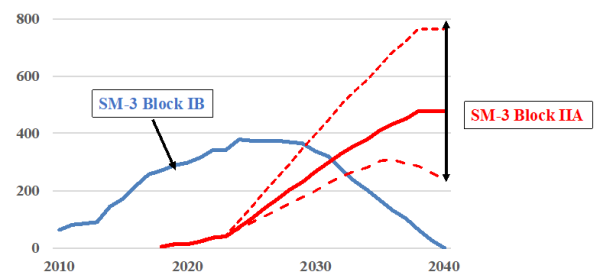In my post “How Many SM-3 Block IIA Missiles?” of January 25, 2016 I made some projections on how many Aegis SM-3 block IIA interceptors the United States might eventually deploy on its ships and at its Aegis Ashore sites. The number of such interceptors is particularly important since these missiles have potentially significant capabilities to intercept intercontinental-range missiles and could therefore derail efforts to reduce the number of strategic nuclear-armed intercontinental-range ballistic missiles (see my post of June 20, 2016). It must be emphasized that these were at best very rough projections.
In the almost two and a half years since I made those projections, there have been some changes in plans and some additional information has become available.
Shortly after my original post, in April 2016, it was announced that the SM-3 Block IA missile would have its service life extended from 8 years to 12 years.[1] Delivery of 150 Block I and Block IA missiles was complete by about 2015. A total of 11 Block I interceptors were delivered and these have all been retired or expended in tests. Taking into account Block IAs expended in testing, the number of Block IAs in service would have peaked at about 120 in 2015-2017 (the most recent Block IA intercept test was in October 2015). This number would then decline steadily until the last Block IA reached the end of its service life in about 2025 (although they could be taken out of service earlier).
Figure 1 below shows the number of Block IB and Block IIA in inventory based on past procurements and my projections of possible future procurements.

Figure 1. Number of SM-3 Block IB and Block IIA interceptors in inventory. Numbers do not include missiles expended in tests or retired because of reaching the end of their service lives. Years are fiscal years.
The curves in Figure 1 up to and including FY 2023 are based on Table 1 of Ronald O’Rourke, “Navy Aegis Ballistic Missile Defense (BMD) Program,” April 27, 2018, and the corresponding tables in earlier versions of this report dating back to 2011.[2]
The blue curve in Figure 1 shows the number of Block IB interceptors in inventory. In September 2015, it was reported that the Department of Defense’s planned to buy a total of 396 Block IBs.[3] Reaching a total buy of 396 would require delivery of 34 Block IBs beyond O’Rourke’s projection for FY 2023, so I assume deliveries of Block IBs ceases in FY 2024 after the 396th missile is delivered. The numbers of Block IBs assumed to be expended in tests are the actual numbers through FY 2017; beyond that one test per year is assumed.
I have not seen a figure for the Block IB service life. As noted above, the Block IA service life was recently extended to 12 years. I assume a service life of 15 years for the Block IB in Figure 1. It is possible that a decision could be made to procure more than 396 Block IBs – such a decision would both increase the peak number of Block IBs and likely also extend the time they remain in service.
The red curves in Figure 1 show the numbers of Block IIA interceptors in inventory. Up to 2023, the number of Block IIAs is from O’Rourke. Beyond that, I make low, middle and higher projections. All three projections assume a 15 year service life (the officially announced figure is 12 years).
Low projection: An April 2016 GAO report stated the United States planned to procure 351 SM-3 Block IIA missiles.[4] This projection assumes deliveries of 24 interceptors per year until a total of 351 are delivered, which would occur in FY 2036. This curve makes it clear that either there will be a successor missile to the IIA or it must continue to be delivered past 2036.
Middle projection: This assumes spending on Block IIA deliveries starting in FY 2024 is approximately equal to the cost of combined Block IB and Block IIA deliveries in FY 2022. MDA projects 37 Block IB and 15 Block IIA deliveries in FY 2022. Assuming the IIA costs about twice as much as the Block IB, this is equivalent to about 33 Block IIAs per year. Deliveries are assumed through FY 2040.
Higher projection: This assumes that, beyond 2023, Block IIA interceptors are delivered at the same rate (52 per year) that was planned for Block IB Interceptors in the 2020s at the time I wrote the original January 25, 2016 version of this blog post. Deliveries are assumed through FY 2040.
——————————————————————————————————————————–
[1] MDA Director Vice Admiral James D. Syring, written statement, Strategic Forces Subcommittee, House Armed Services Committee, April 14, 2016, p. 12. Available at: http://www.mda.mil/global/documents/pdf/FY17_Written_Statement_HASC_SF_Admiral_Syring_14042016.pdf.
[2] Ronald O’Rourke, “Navy Aegis Ballistic Missile Defense (BMD) Program: Background and Issues for Congress,” CRS Report 33745, April 27, 2018 p. 6. Available at: http://fas.org/sgp/crs/weapons/RL33745.pdf.
[3] Jason Sherman, “DOD Reinstates Plan To Buy Nearly 400 SM-3 Block IB Interceptors,” Inside Defense SITREP, September 10, 2015.
[4] U.S. Government Accountability Office, “Missile Defense: Ballistic Missile Defense System Testing Delays Affect Delivery of Capabilities,” GAO-16-339R, April 18, 2016, p. 45 (slide 32). Available at: http://www.gao.gov/assets/680/676855.pdf.